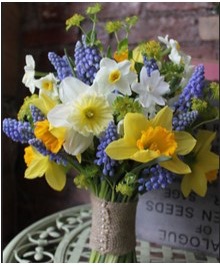Grasses in Your Garden by Sharon Smith
Since early recorded history grasses have fed the world through crops such as corn, wheat, rice and oats, while hay, corn and sorghum feed livestock. So it is a much more recent trend of using grasses in your gardens. Why did this happen you might ask? Gardeners realized that grasses were not just useful but they were beautiful with unique textures and colours. They are now used to great advantage in landscaping.
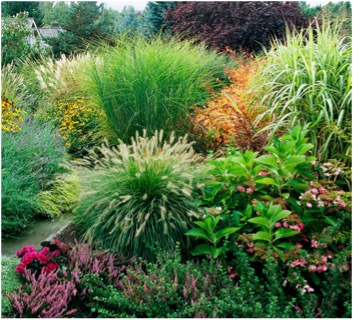
The grass family – Gramineae – is huge with more than 10,000 species and, arguably, is the most successful group of plants on the planet. Naturally, they can be found on virtually every landmass, region, locality and every soil type. Where plants grow you will certainly find local grasses. When you add grass-like plants, including bamboos, rushes and sedges to the equation, it is clear that colour, shape, growth habit and size vary enormously giving grasses and their allies great decorative potential.
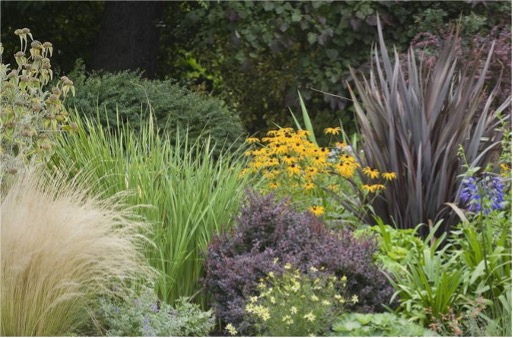
There are both annual and perennial grasses. Annual grass seed germinates, develops into plants that mature, flower, set seed and then die. The released seeds will often germinate the next season. Annual grasses are more often grown for their flower heads and seeds which can be dried beautifully. Perennial grasses will persist year to year, often in the form of creeping plants. The grass stem, known as a culm, is often round and hollow but could be solid. Stem sections are joined by solid joints called nodes. The stems may stand erect or may bend at the joints. Grass roots are very fibrous and some may penetrate deeply. Leaves of grass are called blades and have parallel veins. Often their distinctive leaf structure is what appeals to gardeners along with, perhaps, decorative seed heads. Not only do grasses come in all shades of green but some have a variety of blues, reds and russets, golds and yellows and endless shades of brown or tan in the fall. There is patterned foliage too and variegations including white or ivory and dashes of creams or yellows. Ok so there is desirable foliage but what about other grass features? Grasses can also add a sense of rhythm and movement to a garden. You could consider that wind bends the blades in rhythmic patterns billowing and flowing. On calm days grasses are still and sculptural but in the breeze the movement creates abstract patterns and soothing rustling sounds. It is also eye catching. Grasses are unusual in not having large, colourful flowers to attract pollinators. Instead, the wind spreads grass pollen by air to reach their insignificant flowers. So wind is very important to their ability to reproduce. The flower-bearing stems can be ornamental too through their structure and shape, perhaps with pendulous ornaments, as well as sometimes differing colours from the foliage. Many seed heads can be dried and retained for dry bouquets long after the leaves have died back in the fall.
Grasses have various functions in a garden and can serve a purpose in different conditions including dry, wet, sun, shade, in the landscape or in pots, for erosion control, for habitat restoration, for rain gardens, or other. To have a large selection of ornamental grasses highlighting your garden through the seasons be sure to choose from cool season grasses and those that do well in our summer heat and humidity. Other considerations for placement of grasses include the following:
- As living sculptures including arching shapes;
- Using their unique forms such as tufted, mounded or upright plants;
- As hedgerows or for height;
- For texture and physical properties of the leaves and flowers;
- For colour, variegation and flower heads;
- For special conditions and garden elements (e.g. shade, soil, rock gardens)
- Size and continuity of growth.
Blue Oat Grass
Oat Grass (Helictotrichon) is clump forming and evergreen and there are more than 100 perennial species in this genus. However, the most common one is Blue Oat Grass (Helictotrichon sempervirens). Blue Oat Grass is from dry, rocky mountain areas where it makes silky-looking mounds of blue spike-ended leaves. They do best in dry, sunny positions but will grow in minor shade. It can reaches up to 90 cms tall with pendulous flower stems. The variety “Sapphire” has ornamental steel-blue foliage
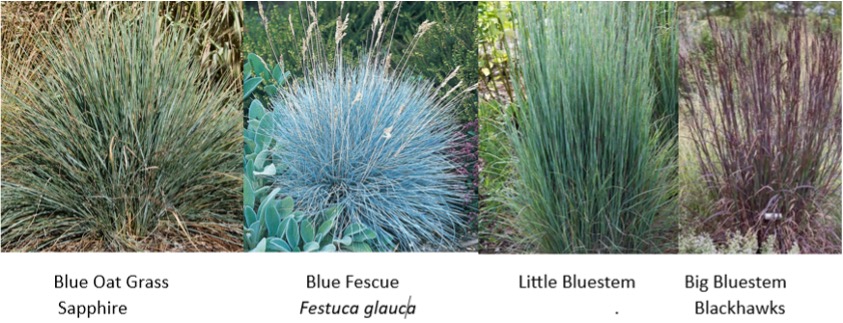
Blue Fescue
Festuca is a huge group of fine-foliage, clump forming perennial grasses. Blue Fescue (Festuca glauca) is a tufted mound-shaped readily available cultivar with fine, narrow leaves in shades of grey and silver to blue. Flower stems are upright becoming a beige colour. It will grow to 40 cms tall and prefers sun and some moisture in the soil. They will produce viable seed that can be planted to make more clumps.
Bluestems
Little Bluestem is tough and adaptable and forms part of tallgrass prairie. Little Bluestem (Schizachryium scoparium) is the only species of this group of grasses that is grown in gardens This grass has a clumping, basal mound of fine-textured strong vertical stalks to 1.2 m tall. Grow it in sun and it can tolerate a range of soils but will be more upright in poorer soils. Foliage and stems are often glaucous to silvery blue and flowers have a contrasting palette of red, orange, copper or rust in autumn. Big Bluestem, Andropogon gerardii, also derived from tallgrass prairie habitat, is long-lived, hardy and tough growing in dry to wet soils. It needs full sun conditions for best performance. If the soil is too rich the plants may flop. The cultivar “Blackhawks” is distinctive with deep purple-green foliage in the spring becoming deeper tones of burgundy to almost black as the season progresses. It grows to 1.5 m.
Northern Sea Oats
Northern Sea Oats (Chasmanthium latifolium), also known now as Wild Oats or Wild Oat Spangle Grass, is very shade tolerant as one of the few true grasses from woodland locations. It will grow to 1.2 m tall with wide ribbon-like, bright green leaves on upright stems. This grass is happy in relatively dry and shady conditions but stems may be more lax than if planted in sunnier conditions where foliage is a lighter green. The nearly flat spires of nodding flowers are eye-catching and turn from green to gold to brown, the same as the foliage does as autumn approaches. These grasses form clumps and are tolerant of clay soils and drought so it is versatile in many locations.
Japanese Forest Grass
Also known as Hakone grass this contains only one species (Hakonechloa macra) originating from moist woodland conditions in the mountains of Japan. It has been cultivated for a long time with many variegated selections. This grass spreads very slowly so it could be considered clump-forming. It is a long-lived grass, very durable and tough and will eventually form a dense, weed proof, predominantly yellow cover. It will grow in full sun to shade for full foliage effect and will get to 50 cms tall. Some lovely varieties you can find locally include “Aureola”, “Lime Zest”, “Albo Striata” and “Old Gold”.
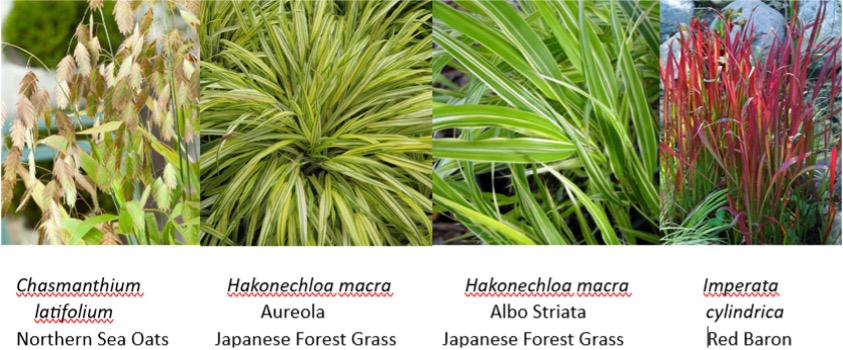
Japanese Blood Grass
This variable species (Imperata cylindrica) is represented in our area by the variety “Red Baron”. “Red Baron” is a slow growing grass with slender upright leaves to 50 cms tall that are green with red tips in spring turning blood red by the fall. They like full sun, where they get their best colours, to part shade in moist well-drained soil, avoiding heavy clay and dry soils.
Maiden or Silver Grasses
Miscanthus grasses, sometimes known as Maiden Grass or Silver Grass with some called Zebra or Porcupine grasses, provide an impressive range of size, leaf and flower colour and are generally tough, long-lived plants. Preferring sunny areas some variegated types can also grow in partial shade. Miscanthus grasses have a long history of cultivation including the striking variety “Zebrinus” that was used by Victorians in formal beds. Depending on their height Miscanthus can be used as screens or even informal hedges. Miscanthus sinensusis the most widely grown species with a large number of cultivars. They are generally all form clumps, taller than wide with masses of flowers level or above the foliage. Plants can grow 1-2 m tall, some with variegated foliage and strikingly different coloured flower heads. Some will produce viable seed so this could be an issue in sensitive areas. Examples of cultivars you can find in Ottawa include “Variegatus”, “Strictus”, “Morning Light”, “Purpurascens”, “Gracillimus” and “Huron Sunrise”.
Feather Reed Grasses
This is a large group of Calamagrostis x acutiflora grasses distinguished by typically upright, sometimes feather-like flowers. They are adaptable and will grow in a range of soils in full sun to part shade. “Karl Foerster” is a common, easily recognizable type growing over 1.5m and most effectively planted in drifts or as a screen. It grows green leaves forming vigorous mounds with dark purple flowers later changing to beige from high summer onwards. This variety is sterile so there is no risk to sensitive natural areas. Another available selection is “Eldorado” which has green leaves striped with yellow down the middle so producing very attractive clumps. Growing up to 1.5m tall it produces soft, feathery greenish-mauve flower plumes in the summer. Another species is Korean Feather Reed Grass (Calamagrostis brachytricha) which forms mounds of green foliage up to 1.2 m with large upward-pointing, arrow-like flower heads. While unfussy about soil type it prefers some moisture and will grow in shady conditions.
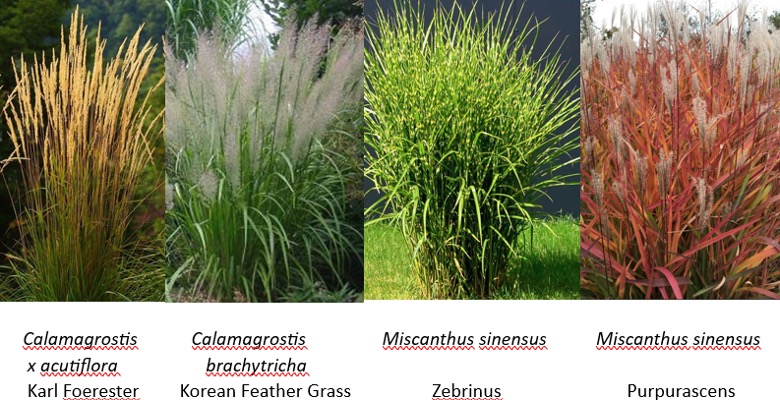
Switch Grasses
Also known as Millet or Switch grasses this large group of grasses includes Panicum virgatum that once formed part of the tall grass prairie and has now given rise to many modern varieties. This adaptable tough grass can be used on a variety of soil types but most prefer a sunny location. In singles or mass plantings they are upright-stemmed and form clumps. Flowers on dainty panicles are often purplish and create a hazy cloud that may obscure the foliage. As with many taller grasses they may bend with heavy rain until righting themselves with improved weather. Ranging from 1-2 m in height with a range of silvery-grey, blue-green changing to burgundy or wine red or golden foliage later in the season. Some of the readily available varieties include “Shenandoah”, “Prairie Winds”, ‘Prairie Dog”, “Blood Brothers”, “Heavy Metal” and “Cheyenne Sky”.
Moor Grass
These cool-season grasses are found in a range of habitats from boggy moors to dry heathlands bringing tough and adaptable qualities to the garden. The Molinia caerulea species grow as clumps with upright, sometimes pendulous linear flower stems up to 1.2 m in different colours and shapes. They prefer sunny, open conditions. Purple Moor grasses (Molinia arundinacea) are among the most graceful plants when in flower. Bright green foliage supports airy flowering stems that strive upwards in an open arc and their sculptural character improves as the season progresses. Of key interest in the fall the stems often collapse under the weight of winter snow. They seed easily. Two available varieties include “Skyracer” and “Variegata”.
Prairie Dropseed
Sporobolus heterolepis is one of the most elegant prairie grasses creating a finely textured, dense mound that turn deep orange to coppery coloured in the winter. Delicate flower panicles are high above the foliage with fresh flowers emitting a slight fragrance of coriander. These grasses are long-lived but slow growing. They prefer full sun and can adapt to a variety of soils. The rich green foliage is very fine and thread-like making an impression of a fountain. This grass can reach 90 cms and is suitable for large rock gardens, native plant gardens and foundation planting borders.
Indian Grass
Another native species Sorghastrum nutans is particularly grown for its ornamental flowers. This clump-forming grass produces blue-green blades that turn gold in the fall, retaining some colour through the winter. The bronze-coppery seed heads are borne on showy plumes with brown overtones which are abundantly displayed in the fall to mid-winter creating stunning vertical garden accents to 1.5 m. This is a very easy to grow grass in full sun in moist or dry locations.

References: Grasses for Gardens and Landscapes, Design, Selection, Cultivation by Neil Lucas, Timber Press, 2023; Ornamental Grasses by Peter Loewer, Better Homes and Gardens Books, 1995.

